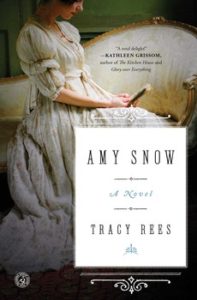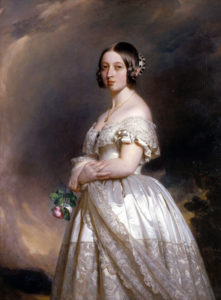 How far will you go for friendship? A secret? (Enderby to London to Twickenham to Bath to York England; early Victorian era, 1831–1848)
How far will you go for friendship? A secret? (Enderby to London to Twickenham to Bath to York England; early Victorian era, 1831–1848)
Amy Snow is a joy to read. For all its length (576 pages, includes reader’s guide and author interview), its charming classical prose, Victorian delights, “meadows and market gardens and mansions that dream away their days,” and clipped chapters make for fast-paced reading you’re sorry ends.
Joyful too is how the novel found its way to us. Winner of the first Richard and Judy “Search for a Bestseller” competition in the UK, their book club influential like Oprah’s.
Its seriousness is disguised in the elegant prose. For it’s not only the story of the depths of friendship between two young women from vastly different social classes, but poignantly depicts the expectations for women in early Victorian society. The time period is perfectly aligned historically to Queen Victoria’s assumption to power, which eventually led to challenging prevailing attitudes about “The Woman Question.”
The plot, which takes many twists and turns, centers around a spirited, eight-year-old Aurelia Vennaway who discovers an abandoned baby in the snow on the grounds of her family’s Surrey estate. She names her “snow baby” Amy Snow. The novel ends after Amy has been led on a clever “treasure hunt” commandeered by Aurelia through a series of letters and cryptic clues, wiser and worldlier than her seventeen orphaned years.
Aurelia comes alive for us only in Amy’s fond memories and her letters, having penned them on her deathbed. The novel opens when she’s died at 25, not much younger than the Queen herself.

Queen Victoria, 1842
Franz Xaver Winterhalter
via Wikimedia Commons
Aurelia may have had a weak heart but hers was a “passionate heart” – an independent, intellectually-minded young woman who loved “philosophy, literature, economics, and politics.” She might have been “considered a humanitarian visionary” if only she was born a man. Her family tried to mold her rebellious, “bluestocking” nature, marry her off for obligation not love, but her deteriorating health ended all that.
She died with a secret she goes to extraordinary lengths to protect and share with the person she trusts the most, Amy. She’ll only reveal it piecemeal, determined to keep her parents, Lord and Lady Celestina, in the dark for their coldness towards their only child reflects, at least in part, their grave disappointment at not bearing an heir. Until Amy, Aurelia was a very lonely child. She describes her parents as:
“People for whom love was a complicated affair, very closely bound up with, and easily confused with, matters of proprietorship, duty, and control.”
There’s not much to like about Aurelia’s mother, although she did let Aurelia keep the baby. Still, she couldn’t be bothered with Amy at all, couldn’t even stand to be in the same room with her. So Amy’s infancy was spent in a busy kitchen underfoot Cook. Think Miss Patmore of Downton Abbey: “big-hearted, capable, and almost always there.” As Amy grew and got more in the way, you could find her in the wheelbarrow of the gardener Robin; or in the hay of the stables under Benjamin; or tagging along Jesketh, the elderly butler. Amy, then, knows how “to hold a currycomb and groom a horse,” “sort through apples,” and adores gardens. When she gets older, she lives in the scullery. Aurelia reads to her; shares her love of literature (especially Dickens, often quoted); teaches her to play piano and cards – cultures her devoted companion.
This all matters because Aurelia has great plans for Amy (“secrets and adventures.”) The first journey takes off when the novel opens at the reading of Aurelia’s will, which means now there’s no place on the estate Amy can live. She’s “accustomed to feeling like an inconvenience,” but without Amy she now aches for a true “sense of belonging.”
But Aurelia has other intentions for her beloved, sisterly friend:
“I have planned for my story to unfold just a little at a time, with every letter taking you farther from Hatville, farther from the ignominy of your treatment there; safer and stronger and freer. By the fourth or fifth letter, the trail will long have run out for anyone else. No one knows me as well as you dear.”
While I can’t reveal the clues and contents of the letters – after all this is your adventure too! – let me share a bit of what awaits you:
Letter 1 sends a grieving, unworldly Amy off to London to Entwhistle’s bookshop, where Letter 2 awaits, hidden. She travels to a “London that demands to be taken seriously” via the miracle of steam locomotives, this being the beginning of Britain’s “Railway Age.” Leaving the bookshop, she briefly encounters the proprietor’s handsome grandson, Henry.
Letter 2 takes Amy to the village of Twickenham, as charming as its name. Thanks to Aurelia, she’s stays at the Mulberry Lodge with three generations of the warmhearted Wister family “brimming over with good feeling.” Waiting for Amy is a trunk Aurelia stuffed with exquisite clothes to “try to feel yourself a young woman of privilege. The clothes will help.” Amy is, of course, stunned and moved by all the ball gowns, in colors suitable and daring, along with “tulle purses stuffed with money.”
Here she meets Henry again, and another handsome man, Quentin, two very different men. Garland is “polished, polite, and poised,” an impeccable dresser, whereas Henry is “all rumpled curls and sprawling limbs.” Quentin “dazzles,” but its Henry who “warmed my heart.” As we get to know both – Henry far more easily and likeably for he shows his tender emotions versus stuffy, “self-contained” Quentin, we see these characters are meant to symbolize two very different perspectives of a woman’s societal place, and the meaning of love.
Aurelia’s plan for Amy is becoming clearer. She wants her to have “the wardrobe and fortune of a grand lady” to open doors for experiences and choices she wasn’t born into, never had, or dreamed of ever having. What path does she choose?
Letter 3 takes Amy to Bath. This time she’s pained to leave behind feelings of family and happiness, but she must find the resolve for Aurelia. The ancient city brings a dramatic turn for here she’s to stay with Mrs. Ariadne Riverthorpe, a hardened, all-mighty 80-year old with a biting tongue and a mind of her own. As the story evolves, you’ll see she’s something else too, something that gets to the heart of the story.
Lovely prose charms us with descriptions of gardens as “earth and apples,” earth as “rainbow and raindrop,” stables as “dust and gleaming.” If we squint real hard, we can see the snowdrops, “daisied grass,” “whirling skirts,” “brush of ladybirds,” we can taste the tipsy cake, and hear York’s minister bells.
The wonder of historical fiction is to authentically transport us in time and place. Tracy Rees beautifully evokes an “elegant and flawless at face value” British Victorian society. With the same finesse, she shows us how “bumpy and biting behind the façade” that society could be.
Lorraine